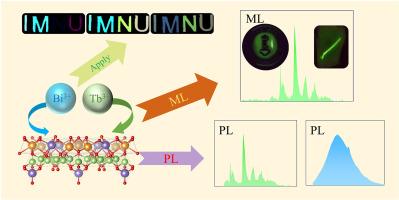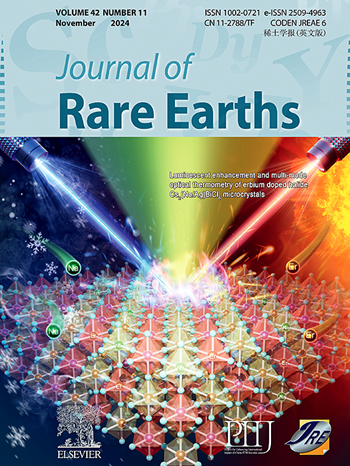Improvement in mechanoluminescence performance and implementation of dual-mode photoluminescence based on Bi3+ ion non-intrinsic defect control strategy
IF 7.2
1区 化学
Q1 CHEMISTRY, APPLIED
引用次数: 0
Abstract
The gallate salts are frequently employed as matrix for mechanoluminescence (ML) materials largely due to their plentiful defect energy levels and robust piezoelectric characteristics. Nevertheless, the ML performance of specific gallate materials is inferior to that of sulfides and fluorides and thus requires improvement. To address this issue, it is essential to engineer appropriate lattice defects in order to facilitate the advancement of new elastic ML materials. Therefore, in the present study, a series of Ca3Ga4O9:0.01Bi3+,xTb3+ (x = 0.01, 0.02, 0.03, 0.04, 0.05 and 0.06) was synthesized using the traditional high-temperature solid-state method. Furthermore, a non-intrinsic defect control strategy utilising Bi3+ ions is presented, which serves to enhance the performance of calcium gallate. The ML intensity is enhanced by 112% in comparison to the undoped samples (concentration of Tb3+ is 0.04), resulting in an improved linearity between mechanical loading and ML intensity, along with the achievement of dual-mode photoluminescence (PL). By analysing the crystal structure, PL, ML, and thermoluminescence (TL) properties of Ca3Ga4O9:Bi3+,Tb3+ (CGO:Bi3+,Tb3+), coupled with the first principles calculations using density functional theory (DFT), the ML mechanism of CGO:Bi3+,Tb3+ was elucidated. This leads to the development of a versatile anti-counterfeiting device with both flexible and rigid multi-mode capabilities.

基于Bi3+离子非本征缺陷控制策略的机械发光性能改进及双模光致发光的实现
没食子酸盐由于其丰富的缺陷能级和强大的压电特性而经常被用作机械发光(ML)材料的基体。然而,特定没食子酸酯材料的ML性能不如硫化物和氟化物,因此需要改进。为了解决这个问题,必须设计适当的晶格缺陷,以促进新的弹性ML材料的发展。因此,本研究采用传统的高温固相法合成了一系列Ca3Ga4O9:0.01Bi3+,xTb3+ (x = 0.01, 0.02, 0.03, 0.04, 0.05, 0.06)。此外,提出了一种利用Bi3+离子的非固有缺陷控制策略,以提高没食子酸钙的性能。与未掺杂样品(Tb3+浓度为0.04)相比,ML强度提高了112%,从而改善了机械载荷与ML强度之间的线性关系,并实现了双模光致发光(PL)。通过分析Ca3Ga4O9:Bi3+,Tb3+ (CGO:Bi3+,Tb3+)的晶体结构、PL、ML和热释光(TL)性质,结合密度泛函理论(DFT)的第一性原理计算,阐明了CGO:Bi3+,Tb3+的ML机理。这导致了具有灵活和刚性多模式能力的多功能防伪装置的发展。
本文章由计算机程序翻译,如有差异,请以英文原文为准。
求助全文
约1分钟内获得全文
求助全文
来源期刊

Journal of Rare Earths
化学-应用化学
CiteScore
8.70
自引率
14.30%
发文量
374
审稿时长
1.7 months
期刊介绍:
The Journal of Rare Earths reports studies on the 17 rare earth elements. It is a unique English-language learned journal that publishes works on various aspects of basic theory and applied science in the field of rare earths (RE). The journal accepts original high-quality original research papers and review articles with inventive content, and complete experimental data. It represents high academic standards and new progress in the RE field. Due to the advantage of abundant RE resources of China, the research on RE develops very actively, and papers on the latest progress in this field emerge every year. It is not only an important resource in which technicians publish and obtain their latest research results on RE, but also an important way of reflecting the updated progress in RE research field.
The Journal of Rare Earths covers all research and application of RE rare earths including spectroscopy, luminescence and phosphors, rare earth catalysis, magnetism and magnetic materials, advanced rare earth materials, RE chemistry & hydrometallurgy, RE metallography & pyrometallurgy, RE new materials, RE solid state physics & solid state chemistry, rare earth applications, RE analysis & test, RE geology & ore dressing, etc.
 求助内容:
求助内容: 应助结果提醒方式:
应助结果提醒方式:


